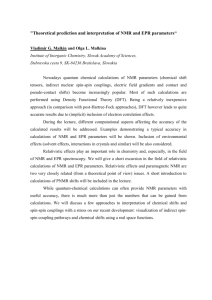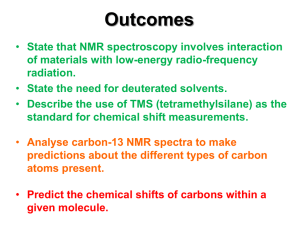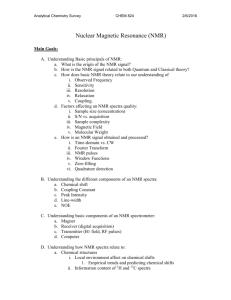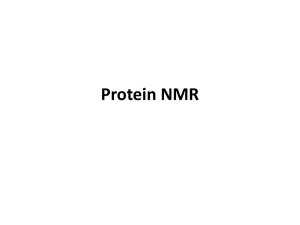Lecture 1
advertisement
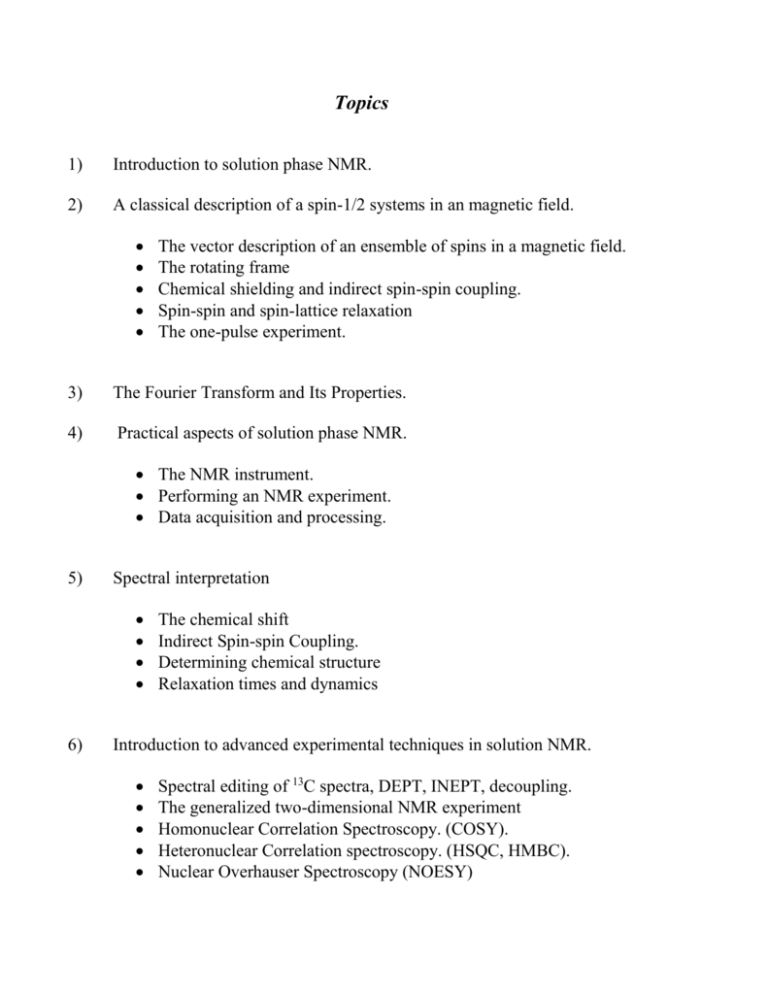
Topics 1) Introduction to solution phase NMR. 2) A classical description of a spin-1/2 systems in an magnetic field. The vector description of an ensemble of spins in a magnetic field. The rotating frame Chemical shielding and indirect spin-spin coupling. Spin-spin and spin-lattice relaxation The one-pulse experiment. 3) The Fourier Transform and Its Properties. 4) Practical aspects of solution phase NMR. The NMR instrument. Performing an NMR experiment. Data acquisition and processing. 5) Spectral interpretation 6) The chemical shift Indirect Spin-spin Coupling. Determining chemical structure Relaxation times and dynamics Introduction to advanced experimental techniques in solution NMR. Spectral editing of 13C spectra, DEPT, INEPT, decoupling. The generalized two-dimensional NMR experiment Homonuclear Correlation Spectroscopy. (COSY). Heteronuclear Correlation spectroscopy. (HSQC, HMBC). Nuclear Overhauser Spectroscopy (NOESY) 7) A time-independent quantum mechanical treatment of NMR. 8) A time-dependent quantum mechanical treatment of NMR. 9) The NMR Hamiltonian The matrix description of a spin-1/2 system. Simulation of static spectra of mutlispin-1/2 systems. The time evolution of a spin system The Time Dependent Schrodinger Equation The density matrix Evolution of a single spin under the NMR Hamiltonian Evolution of two-spins under the NMR Hamiltonian Theoretical descriptions of time dependent NMR experiments and experimental considerations. The INEPT Experiment The COSY Experiment The HMBC and HSQC experiment The NOESY and EXSY experiments. Introduction to solution phase NMR What information can NMR provide? NMR can be divided into four categories: A) B) C) D) 1 One dimensional techniques. Two-dimensional techniques Solid state spectroscopy Magnetic Resonance Imaging One-dimensional spectroscopy - Primarily concerned with spectral parameters ie. Chemical shifts and indirect coupling constants (J) - Limited to application to systems with relatively few spins. Directions of investigation - Increasingly, more types of nuclei spin-1/2 are becoming routinely investigated. For example: transition metals (especially useful in inorganic chemistry) Common nuclei: 1 H, 1F, 31P high natural abundance, high Rare nuclei: 13 C, 15N, 29Si, 109Ag, 119Sn, 195Pt, 199Hg Either low natural abundance, low or both. - Often dynamics can be observed directly in the spectrum when the rate of the process in question is on the NMR time scale or when is often observed to affect the relaxation behavior of the nuclei of interest. - Liquid Crystal solvents give rise to residual dipolar couplings which in turn give very accurate internuclear distances when the order parameters are known. This is seeing broad application in the study of proteins. An two-spin System Undergoing Mutual Exchange H H H H H k B H H HA N N HA O HB O 1 0.8 0.6 0.4 0.2 0 2070 2080 Slow: 2090 2100 2110 1 0.8 0.8 0.6 0.6 0.4 0.4 0.2 0.2 0 0 2080 2090 2100 2110 2120 2130 2130 Rate = 1.4 s-1. Temp = 297 K 1 2070 2120 2070 2080 2090 2100 2110 2120 Intermediate: Fast: Temp = 330 K Rate = 3.6 s-1. 1 . Temp = 351 K Rate = 175 s- 2130 2. Two-dimensional methods - Primarily concerned with determining connections between spins. These connections are based on some type of physical interaction such as: J couplings i) Homonuclear - between the same type of nuclei COSY (short range) TOCSY (long range) ii) Heteronuclear - between different types of nuclei HSQC (short range) HMBC (Long range) Cross-relaxation i) Correlation based on the Nuclear Overhauser Effect (NOE) - provides distance and kinetic information in solution phase. Directions of investigation - Two-dimensional and consequent n-dimensional NMR is one of the primary methods of obtaining structural information of large organic systems (ie. pharmaceuticals) to large biological macromolecules (ie. proteins). - Detailed stereochemical information can often be obtained - 3-D methods exists that make it possible to sequence a protein given the appropriate isotopic labeling of the given protein. A hybrid sequence combining TOCSY with HMBC makes it possible to correlate intra and inter-residue backbone H resonances with N resonances. -N(H)-C(R)H-C(=0) -N(H)-C(R)H-C(=0)A similar sequence exist that correlate backbone carbon resonances to nitrogen resonances and subsequently to the corresponding NH. -N(H)-C(R)H-C(=0) -N(H)-C(R)H-C(=0)Sequences are also available that correlate H to the corresponding Cto the nearest N and subsequently to the corresponding NH -N(H)-C(R)H-C(=0) -N(H)-C(R)H-C(=0)- Example – COSY spectrum of Camphor H3C CH3 CH3 O 13 C NMR spectrum with H decoupling DEPT Spectra HSQC spectrum of Camphor HMBC Spectrum of Camphor 3 Solid-state NMR spectroscopy - The main impetus behind solid-state NMR spectroscopy is to find ways to suppress linebroadening mechanism in order to attain “solution like” quality spectra. Both 1and 2-dimensioanl techniques have been developed for solid state. - Direct dipole-dipole interactions, chemical shift anisotropy, and quadrupolar interactions that are not present in the solution state. The parameters of these interactions give valuable information about the electronic structure of the system. - Magic angle spinning and multiple pulse decoupling methods are used to suppress these interaction. - Cross-polarization methods are developed to increase the signal from rare spins. Directions of investigation - Study of insoluble proteins that cannot be the crystallized. Present work is limited to small systems that are often selectively labeled. Two-dimensional methods rely on recoupling to establish correlations. - Multiple quantum NMR methods have been developed to study quadrupolar systems and to enhance resolution in proton spectroscopy. MAS Side-Band pattern of a Cylindrically Symmetric Tensor 4 Magnetic Resonance Imaging - Developed historically as a branch of physics. - Gradients are superimposed on the magnetic field in three orthogonal directions, thus making the resonance frequency depend on position. Many signals are collected under varying gradient settings. Like a 2-D spectrum, the signal undergoes a 2-D FT resulting in an image reflecting the proton density of the sample at a given slice (position along the Z-direction). - This subject will not be covered in this course. Removal of a brain tumor from a nine-year-old child. Figure 1, a preoperative MRI image, proves the presence of a tumor as illustrated by the white mass. Figure 2, an intraoperative image, taken at a different angle, shows tumor remaining and prompts further action during. The same surgery. Figure 3, taken five months after surgery, shows the tumor is gone entirely, with no signs of regrowth.



